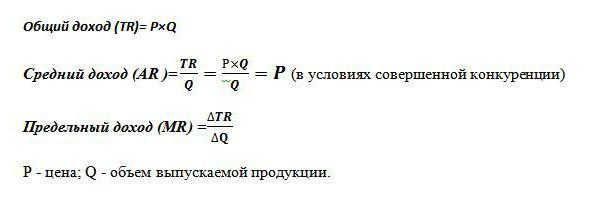Monetary assessment of the business entity is income. With the growth of this indicator appear: the prospect of further development of the company, the expansion of production and increase in the volume of output of goods / services. To maximize profits and determine the optimal volume of output in management, a marginal analysis is used. Since profit does not always have a positive trend with an increase in the output of goods / services, therefore, a favorable state of affairs at a firm can be achieved when marginal revenue does not exceed marginal cost.
Profit
All funds that enter the account of the company during a specific period of time before taxes are called income. That is, when selling fifty units of goods at a price of 15 rubles, an economic entity will receive 750 rubles. However, in order to offer its products on the market, the enterprise acquired some production factors and expended labor resources. Therefore, the end result of entrepreneurial activity is considered a profit indicator. It is equal to the difference in total income and total costs.

From such an elementary mathematical formula it follows that the maximum values of profit can be achieved with an increase in income and a decrease in expenses. If the situation is reversed, then the entrepreneur incurs losses.
Types of income
To determine profit, the concept of “total income” was used, which was compared with the same type of costs. If we recall what the costs are and take into account the fact that the two indicators are comparable, then it is easy to guess that by type of expenses of the company there are similar forms of income.
Total revenue (TR) is calculated as the product of the price of the good and the volume of units sold. Used to determine the total profit.
Marginal revenue is the additional cash amount to total income received from the sale of one additional unit of good. It is designated in the world practice as MR.

Average revenue (AR) shows the amount of cash that the company receives from the sale of one unit of output. In conditions perfect competition when the price of a product remains unchanged with fluctuations in sales volumes, the average income indicator is equal to the price of this good.
Examples of determining different incomes
It is known that the company sells bicycles at 50 thousand rubles. 30 pieces are produced per month. wheeled vehicles.
Total revenue is 50x30 = 1,500 thousand rubles.
Average income is determined from the ratio of total revenue to the volume of output, therefore, at a constant price for bicycles, AR = 50 thousand rubles.
In the example, there is no information about the different costs of the products. In this case, the marginal income is identical to the average revenue and, accordingly, the price of one bike. That is, if the company decided to increase the production of wheeled vehicles to 31, at a constant cost of additional goods, then MR = 50 thousand rubles.

But in practice, no industry has the features of perfect competition. This model of a market economy is ideal and serves as a tool in economic analysis.
Therefore, the expansion of production does not always affect profit growth. This is due to the different dynamics of costs and the fact that an increase in output entails a reduction in the price of its sale. Supply increases, demand decreases, as a result, the price also decreases.
For example, increasing the production of bicycles from 30 pcs. up to 31 pcs.per month resulted in a decrease in the price of goods from 50 thousand rubles. up to 48 thousand p. Then the marginal revenue of the company amounted to -12 thousand p:
TR1 = 50 * 30 = 1500 thousand p;
TR2 = 48 * 31 = 1488 thousand rubles;
TR2-TR1 = 1488-1500 = - 12 thousand p.
Since the increase in income was negative, therefore, there will be no increase in profit and it is better for the company to leave the production of bicycles at 30 units per month.
Average and marginal cost
To get the maximum benefit from economic activities in management, an approach is used to determine the optimal volume of output based on a comparison of two indicators. This marginal revenue and marginal cost.
It is known that increasing production volumes, increasing costs for electricity, wages and raw materials. They are dependent on the amount of goods produced and are called variable costs. At the beginning of production, they are significant, and with an increase in the output of goods, their level decreases due to the economies of scale. Amount fixed and variable costs characterizes the indicator of total costs. Determine the amount of funds invested in the production of a unit of good, help average costs.
Marginal cost allow you to see how much money the company will need to spend in order to produce an additional unit of product / service. They show the ratio of growth in total economic spending to the difference in production volumes. MS = TC2-TC1 / Volume2-Volume1.
A comparison of marginal and average costs is necessary to adjust output volumes. If the feasibility of increasing production is calculated, at which marginal investments exceed average costs, then economists give a positive answer to the planned actions of the leadership.
Golden Rule
How can I determine the maximum amount of profit? It turns out that it is enough to compare marginal revenue with marginal costs. Each unit of good produced increases total revenue by marginal revenue and total costs by marginal cost. As long as the boundary income exceeds similar costs, then the sale of an additionally produced unit of production will bring profit and profit to the business entity. But as soon as the law of diminishing returns begins to operate and the marginal expenditures exceed the marginal revenue, then a decision is made to stop production at a volume at which the condition MC = MR is met.

Such equality is the golden rule for determining the optimal output, but it has one condition: the price of the good must exceed the minimum value of the average variable costs. If in the short-term period the condition is fulfilled when the marginal income is equal to the boundary costs and the price of the product exceeds the average total expenses, then there is a case of profit maximization.
An example of determining the optimal output
As an analytical calculation of the optimal volume, fictitious data are taken, which are presented in the table.
| Volume, units | Price (R), rub. | Income (TR), rub. | Costs (TS), rub. | Profit (TR-TC), rub. | Marginal revenue, rubles | Marginal cost, rub. |
| 10 | 125 | 1250 | 1800 | -550 | ||
| 20 | 115 | 2300 | 2000 | 300 | 105 | 20 |
| 30 | 112 | 3360 | 2500 | 860 | 106 | 50 |
| 40 | 105 | 4200 | 3000 | 1200 | 84 | 50 |
| 50 | 96 | 4800 | 4000 | 800 | 60 | 100 |
As can be seen from the table, the company has a model of imperfect competition, when with an increase in supply, the price of products decreases, but does not remain unchanged. Income is calculated as the product of volume and the value of the good. The total costs were known initially and after calculating the income helped to determine the profit, which is the difference between the two quantities.

The marginal values of costs and income (the last two columns of the table) were calculated as the quotient of the difference in the corresponding gross indicators (income, costs) per volume. As long as the enterprise’s output is 40 units of goods, maximum profits are observed and border costs are covered by similar revenues. As soon as the business entity increased the output to 50 units, a condition occurred under which the costs exceeded the income.Such production has become unprofitable for the enterprise.
Total, marginal revenue, as well as information on the cost of goods and gross costs, helped to identify the optimal volume of output at which maximum profit is observed.








